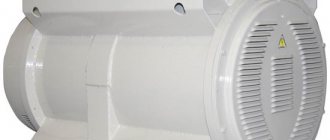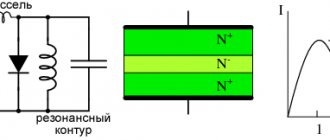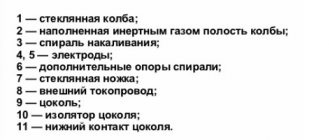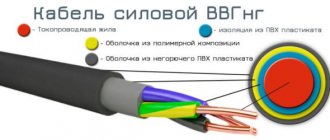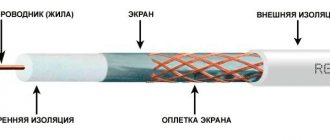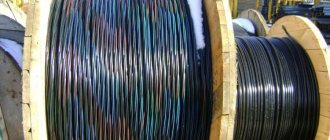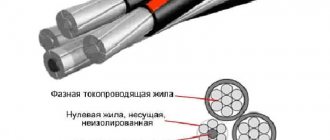Coaxial cable
RK-75-1,5-11
RK-75-2-11
rk75-4-11
Coaxial cable boasts the widest distribution and popularity. Inside it there is a copper core, surrounded by a layer of foam dielectric, covered, in turn, with a special protective shell (screen).
The purpose of the shielding layer is to prevent the negative effects of interference during signal transmission. Common types of coaxial cables used in the installation of video surveillance systems include products of the RK series, namely 75-2-13, 75-4-12, as well as a number of analogues of foreign manufacturers of the RG series - 6, 11 and 59.
When choosing a cable, consider the following features - the installation location, as well as the required length. If the video camera is located at a great distance from the recorder (beyond 250-300 m), the signal may weaken during transmission. It is worth remembering here that the thinner and longer the cable, the more significantly the transmitted signal is attenuated.
Consider a number of recommendations regarding the product used and the length of the gasket:
- RK-75-1.5-11 is used if the distance to the video camera does not exceed 50 m.
- RK-75-2-11 is suitable at a distance of 300 meters from the recorder.
- RK-75-4-11. The use of this cable is allowed when the video camera is located at a distance of 600 m from the fixing device.
As for foreign analogues, such as RG-59 or 6U, they can be used at a distance between the recorder and video camera of 600 and 650 m, respectively. To avoid mistakes when choosing, it is important to carefully study the characteristics of the cable and take into account the features of its installation.
Pay attention to the material of the center conductor - it should be made of copper. If this is not the case, the transmitted signal will be too weak. In addition, when choosing, focus on the following characteristics:
- Flexibility. If during the installation process you plan to bend the product at several points, it is advisable to buy a cable with a multi-core “core”, which allows you to bend it without the risk of damage.
- Anti-interference level (shield must be provided).
- Resistance (wave). There are two options here - 50 and 75 Ohms. When installing a video surveillance system, a cable with a rating of 75 Ohms is used.
- The degree of signal attenuation.
The advantages of coaxial cables include noise immunity and versatility. They can be used to transmit audio and video signals. Disadvantages include the need for high costs for the purchase of connecting devices (connectors), fragility and restrictions on the length of the gasket.
Types of cables for video surveillance systems
1. Coaxial cable
Everyone is familiar with this type of cable. This is the well-known so-called antenna cable. It is a copper conductor, which is located in a foamed dielectric. The latter, in turn, is covered with insulating material to minimize the impact of interference and signal loss. Used to connect analog CCTV cameras. Of the domestic brands, these are well-known radio frequency cables marked RK-75-2-13, RK-75-4-12. But the best solution would be to use an imported cable with a thicker conductor and transmitting a wider range of frequencies. The choice can be made from brands RG-59, RG-6, RG-11. Features include the need to lay a separate line to power CCTV cameras. Convenient if power and video signal transmission are carried out from different points. Used for analog video surveillance systems (AHD/HD-TVI/HD-CVI/CVBS).
2. High frequency combination cable
If the camera is powered and the video signal is transmitted from one point, then it is more convenient to use a combined high-frequency cable with power cores - KVK. It is a coaxial cable with a characteristic impedance of 75 Ohms in combination with power wires, which allows you to provide power to the camera without laying additional wires. They are classified into cables for indoor installation (KVK-V) and cables for outdoor installation (KVK-P). The KVK-V shell is made of PVC and has a white color. For external installation, KVK-P cables with a black sheath are used. These cables have a polyethylene sheath that is not susceptible to low temperatures and ultraviolet radiation. The cable is presented on the market with two variations of cross-section: 0.5mm and 0.75mm. Used for analog video surveillance systems (AHD/HD-TVI/HD-CVI/CVBS).
3. Symmetrical cable ( single pair)
It is used to build both analog video surveillance systems using video baluns and digital video surveillance systems using IP cameras. It consists of 8 conductors insulated and twisted in pairs with a certain number of turns per unit cable length. All conductors are placed in a protective sheath. It is classified into regular cable (UTP), shielded cable (FTP) and non-flammable cable with a special type of shielding (STP). It is also divided into cables for indoor installation with PVC insulation (gray color) and for outdoor installation with polyethylene insulation (black color). It is also worth selecting a non-flammable cable with no toxic substances marked FRLTx.
We hope our article was useful to you!
Best regards, Group
Return to list
twisted pair
The use of twisted pair cables became widespread with the advent of computers. This type of cable is used when connecting a PC to the Network, installing digital surveillance cameras, various electronic devices and when creating computer networks. Structurally, a twisted pair consists of eight thin wires, which are combined in pairs and covered with a common sheath on top.
UTP FTP STP
Depending on the design, the following types of such cables are distinguished:
- UTP is the simplest type of product that does not have a protective screen. This cable has a low price, but it is not resistant to interference, so when laying in close proximity to electrical wiring, it is recommended to use other types (with high noise immunity).
- FTP is a cable with a common protective sheath of foil. The presence of a screen allows installation in close proximity to the wiring without worrying about interference. During installation and operation, it is important to monitor the integrity of the foil, avoiding excessive bending. External cable protection is provided using solid polyethylene or PVC.
- STP. A feature of products of this type is the presence of a more powerful screen (copper braid is used). In addition, the conductors in the cable are also made of solid copper, insulated with polyolefin and have a personal foil shield. Fire-resistant polyvinyl chloride is used as external insulation. An STP cable is the best option when the video camera is connected at a distance of more than 90 m from the recorder and in the presence of a lot of interference.
When choosing, pay attention to a number of characteristics - the diameter of each conductor, the speed of information transfer, the type of outer sheath, as well as the number of cores (single- or multi-core).
The advantages of the cable are ease of installation, low cost (when compared with a coaxial product), the ability to transmit a “picture” over a distance of up to 3000 m, as well as wide functionality. The disadvantages are the low level of protection against interference (for some types), as well as the need to install amplifiers when installing video surveillance over long distances.
Which video surveillance cable is best to choose?
When planning a video surveillance system, the cable plays an important role and is the main element. The operation of the entire system and its individual components depends on the correct choice of wire. In this article we will talk about the main types of cable and the features of choice.
The correct choice of video surveillance wire depends on the following:
- the quality of the video signal, in other words, the resulting image;
- synchronous functioning of the entire system;
- power supply for cameras and other components.
When choosing a cable for video surveillance, you should pay attention to the type of cameras used, at what distance they are from the power source, and what interference exists.
There are several types of cable. They differ from each other in scope and technical characteristics. Let's look at each of them in more detail.
Coaxial cable for video surveillance
This type of wire is suitable for connecting AHD, CVI, TVI and standard analog video cameras. It is a copper core enclosed in a dielectric layer and covered on the outside with a protective sheath. The screen is responsible for preserving the signal and protecting against interference. The protective shell can be intended for outdoor and indoor wiring. Outdoor wire for a video surveillance system is resistant to external influences, usually sold in black. The internal cable for video surveillance is gray or white.
The advantages of coaxial cable include:
- reasonable cost;
- resistance to interference;
- the ability to transmit video or audio signals.
Combined video surveillance cable (CVC)
This type of wire is also used for AHD, CVI, TVI and standard analog video surveillance; it is a coaxial cable combined with power wires. This interweaving allows you to install video cameras without the use of additional wires. Each camera is connected to the network in the same place where the recorder is installed. To do this, you will need one (if you use a splitter) or several power supplies.
KVK cable for video surveillance has its advantages, which include:
- no need to use additional wiring to transmit power to the cameras;
- the ability to transmit both audio and video signals through the coaxial part of the cable;
- interference protection;
- ease of installation work.
The combined cable can be purchased either in a coil (additionally, BNC and power connectors are required), or ready-made with connectors (several fixed lengths). The cable for video surveillance systems of this type is most in demand and is actively used at various facilities - apartments, offices, cottages, houses, shops.
Pre-made video+power connection cords are a simple solution for connecting cameras or microphones to a recorder. Standard analogue cameras, AHD cameras and microphones can be removed at a distance of up to 180 m (for some camera models up to 240 m), digital HD-SDI cameras - up to 90 m (without the use of amplifiers). The signal quality is not lost.
Twisted pair cable and its features
Wiring of this type is mainly used in video surveillance systems with IP cameras when the camera is located at a distance of no more than 100 meters from the signal receiving device.
These CCTV patch cords transmit video and audio signals and can also be used to supply power to cameras (requires camera support for POE technology and additional equipment).
There are a large number of conductors under one braid, which allows you to solve a variety of problems and even connect additional functionality (control a microphone, cameras, motion sensors). Copper wires are twisted together, insulated and wrapped in a plastic sheath.
What should you consider when choosing a cable?
A correctly selected cable for video surveillance is a guarantee of uninterrupted operation of the equipment, high-quality signal, and image. To be sure of purchasing quality products, you should buy a product from a well-known brand, and also, if you have a choice, do not save money by choosing a cable with a small core cross-section. You should avoid cords where the conductor is copper-plated steel.
The choice of wiring largely depends on:
- camera parameters (number of IR LEDs, availability of additional functions and built-in microphone, etc.);
- camera type (AHD, CVI, TVI, standard analog, IP, digital HD-SDI, etc.);
- the presence of potential sources of interference, the distance from the camera to the recorder.
To remove most AHD and standard analog cameras at a distance of 100-200 meters, a combined (signal + power) coaxial cable like KVK-P-2*0.75 is suitable. For long distances, as well as for cameras with powerful IR illumination, it is recommended to use RG59 or RG6 cables separately for signal transmission, and cables with a cross-section of 1 square meter for power transmission. mm or more.
It is worth keeping in mind that the cable for AHD cameras is different from the cable for HD-SDI cameras. The HD-SDI standard is more demanding on cable quality compared to analogue options, since the output signal from the camera is digital and is transmitted without compression. This allows you to obtain the highest quality images. One such camera can replace several analog ones, has high light sensitivity and a high degree of reliability.
Wires also differ in scope of application. The internal cable for video surveillance is made in a PVC sheath without additional protection. Wiring intended for outdoor use takes into account the possibility of mechanical impact and the influence of weather conditions.
Conclusion
Depending on the type of cameras used, their distance from the recorder and power source, place of use, the presence of interference sources and, of course, the financial capabilities of the buyer, you can choose one or another cable for video surveillance. The correct choice largely determines the quality of the image, the stability of signal transmission and the functioning of the entire system as a whole.
_________
© YuControl. All rights to photographs, texts, drawings belong to the YuKontrol company. Full or partial copying, reproduction in printed form and/or use in any form, quoting without the written permission of the copyright holder is prohibited. When using site materials in an agreed manner, a link to the resource is required.
Combination cable
KVK-V-2
KVK-2P
When connecting analog video cameras, a combined cable is usually used. Essentially, this is the classic coaxial type, which is combined in an insulating sheath with 2 or 4 conductors. It is used to solve the following tasks: connecting a microphone, transmitting control signals, and supplying power to the camera. The disadvantages of a combined cable include the high price and the need to connect the video camera to a separate power supply. On the other hand, it is noise-resistant and can be laid over long distances. The most popular types of devices are KVK-V-2 and KVK-2P.
Optical cable
Optical fiber is a fairly high-quality instrument designed to transmit a high-quality signal over a considerable distance. Due to its high cost and difficulty in operation, as well as its relatively fragility, such a cable is actually not used in a surveillance system. In addition, it can be used at private and strategically important facilities. Usually installed on expensive multimedia systems, because they are capable of transmitting high quality audio and video signals without various distortions.
For IP video surveillance
UTP cable with RJ-45 connectors
In addition to the USB cable discussed above, another type of product is used for IP surveillance cameras. We are talking about a UTP cable with RJ-45 connectors installed at the edges. The main advantage is the possibility of using one twisted pair cable for the entire video surveillance system with the mandatory installation of a special switch.
In this case, the cameras are powered in one of three ways - by connecting individual cables to each device by installing a power supply or by using unused twisted pair wires. The last method is relevant for cases where the video camera and switch support PoE technology.
What types of cables are there for video surveillance?
The installation and installation of a CCTV system is entirely dependent on cables, which are used for all cameras except those considered wireless. If you don’t know what a video surveillance cable is needed for, then we will try to describe its essence briefly and clearly. The point is that it is a means of transporting data to an additional source, and also, if necessary, connects a microphone to the system for recording sound.
There are a lot of different cables on the modern market, but we will only talk about those that are more common and frequently used. The choice of cable itself is made based on the type of camera. For example, an IP video system requires a twisted pair cable.
A wire can not only transport information, but also serve as a power source for your system. You will learn these and many other features of video cables from the material that we have prepared for you. Enjoy reading!
Types of cables for surveillance cameras
As we already said, there are many cables, but not all of them work with a particular camcorder.
Having figured out which video surveillance cable you need, we suggest you learn about each type of wire in more detail. The characteristics of a specific option will help you determine the required cable for your equipment. We have prepared the TOP 5, it includes five “pillars” on which the entire world of video surveillance rests. Let's look at each wire in more detail.
Coaxial cable
If you are a user of analog video surveillance, then the cable that will suit you best is coaxial wire. In appearance, it is similar to the one that connects the antenna to a TV or some other receiver. This type of cable is the most protected from any mechanical impact, since it is covered with a special shielding sheath, which ensures the safety of the wire. By the way, if the video surveillance cable is shielded, it will not create interference or unnecessary noise, which is very important for the smooth operation of tracking systems.
As an example, let's take domestic radio frequency cables RK-75-2-13 and RK-75-4-12. Many people in Russia use them, so don’t worry, they are really of excellent quality.
twisted pair
When wondering what cable is used for remote video surveillance, the thought of twisted pair immediately comes to mind. These cables are capable of operating over such long distances that the laying length can be 3 km, but no more. The twisted pair video surveillance cable is universal and loved by many for many reasons, here are the main ones:
- Possibility of using from a distance.
- All necessary conductors are located under a common braid.
Let's look at the second case in more detail. What does this give us? - you ask. Each wire is responsible for its own function. For example, one can connect a recording microphone, and the other will act as a power source. If we talk about twisted pair, then all these functions are connected into one cord. This is the versatility of the cable.
There is also a fiber optic cable, which is an order of magnitude different from twisted pair. Fiber optic surveillance is an outdoor option with minimal signal loss.
Stranded
Without straying too far from the topic of twisted pair cables, we want to look at another type of wire. In fact, this is rather a subspecies, since a multi-core video surveillance cable is a twisted pair cable.
The point of this wire is that it does an excellent job of connecting digital devices, and it can easily transmit information from one source to another. The 4-wire CCTV cable is perfect for uneven areas.
The wire tolerates bends and twists quite calmly, as it is made of special copper cores with increased flexibility. The very name “multi-core” is due to the fact that one cord includes 3 or more of these same veins.
Combined with video camera power supply
Powering video cameras from one place requires a combined cable for video surveillance systems. In fact, there are no restrictions on other types of cables. But the one we are describing now is much more suitable. The wire can be used for absolutely any system: digital and analog.
Combination cable is considered a subtype of coaxial wire. The way it is. If you need a video signal amplifier over a coaxial CCTV cable, then using this wire will provide you with this opportunity.
If you look at the structure of the wire, it is made by weaving several cables together. This provides fast and convenient power to the entire video surveillance system. In some models, the cable is capable of connecting a recording microphone to the camera, but its main essence is the responsibility for power supply.
If you don't know how to connect CCTV cables, do the following:
- Cut the cables, remove the insulation, wrap the braid back into the sheath.
- Connect the cables by soldering.
usb cable
If you are using IP video cameras, you will need a USB cable. It is used to connect the device to a personal computer to monitor what is happening. The same cable is used to connect the camera to a router, which creates a signal that transports incoming information to a PC.
The cable for IP video surveillance is quite secure. As mentioned earlier, those wires that are covered with shielding film are considered to be of higher quality. She is present here. This means that the cable is resistant to mechanical damage, which will increase its service life.
Useful tips for choosing
In conclusion, we highlight the main recommendations that will help with the correct choice of cable for video surveillance:
- When installing IP cameras, the best solution is to use a UTP cable with an RJ-45 connector.
- For analogue video surveillance, the classic “coaxial” is suitable if the distance between the camera and the recorder is no more than 100-300m.
- In a situation where signal transmission and power supply are carried out via one cable, it is better to use a combined option.
- If you use a large number of cameras, you should use STP, FTP or UTP cables. Here, focus on distance and the need for protection from interference.
- For outdoor cameras, use products with a protective shell made of rigid polyethylene. When installing a video surveillance system inside various structures, a cable with a PVC sheath is suitable. If you need to mount an external system, it is desirable that the cable structure has a steel cable, which provides greater strength to the product (relevant if there is an air laying).
Review of cable brands for video cameras
For reliable and stable transmission of an analog signal in AHD, CVI or TVI formats, three types of wires are used, each of which has its own characteristics:
- Coaxial
. The central single-core wire is insulated, which separates it from the shielding braid. The most common brands of cable of this type are ElectroHouse RG-6U EH-1, RCI RG660BV-W and KLM RG690BV-W. - Twisted pair
. These are mainly wires of two types cat 5e and cat 6 to improve the transmitting characteristics that can be used by transceiver devices. Among specialists, the most popular patch cables are C5-SF/U-24/7HPUR (4 pairs) and FTP c.5E 4x2x0.51 mm2. - Combined
. The cable is a classic coaxial wire combined with current-carrying power conductors. Each of them is enclosed in its own insulating shell, connected to each other in parallel. The most widely used cables in our country are combination cables of two types KKSEV and KKSEP, the latter includes KKSEPG-3 2x0.75+1x0.20 with a flexible central core.
When producing equipment for visual inspection systems, the same standards are used as when creating the Internet. In particular, in the connection line for the outdoor video camera, the cable uses standard UTP with classic RJ45 connectors. One of the advantages of this scheme is the ability to switch several cameras at once using a switch. At the same time, the range of signal transmission from such a group of devices increases and significantly exceeds the performance of even the most advanced analog systems.
When laying a UTP cable to power street video cameras, adhere to the following rules:- The twisted pair is suspended on a cable or wire.
- Fastening to the carrier is carried out at regular intervals, eliminating the possibility of sagging.
Operating voltage is supplied to the cameras in one of three ways:
- Over a dedicated twisted pair line.
- Using a separate power supply.
- Using a free pair of UTP cable wires from a switch with PoE (Power-over-Ethernet) function.
The choice of one or another connection scheme is determined by the capabilities of the equipment used. The operating voltage on such switches, including passive injectors, can reach 50 V. This solves the problem of power supply for remote objects and image transmission over long distances.
Correct cable routing along the façade
Video surveillance systems have become an integral part of our lives. And it is almost impossible to imagine a business or private house/cottage without video surveillance. There is one caveat - no one wants to make mistakes so as not to have to redo the work again or have to pay for installation or equipment again. To prevent this, we recommend contacting only specialized companies with extensive experience and an excellent portfolio
.
Such companies provide an extended warranty on the work performed, which is a definite advantage. why you should not use single installers
in our previous publication.
Well, we strongly do not recommend purchasing only proven, certified equipment with a working warranty. For the most curious, we discussed “ why you shouldn’t buy video surveillance from China
.” But there are often cases when people, turning to specialized companies with experience and guarantees, receive a bunch of standard errors. To avoid this, we suggest you read these very useful articles:
- Installer inspection checklist
- TOP 10 mistakes when installing video surveillance systems
- Errors in installing CCTV cameras
Today we will discuss with you the issue of laying cables along the facade. What materials are best not to use when laying cables so that the video surveillance system works for a long time and reliably. Mistakes can also be made in this matter. Errors, of course, can be corrected, but they cost certain costs, including financial ones. And our goal is to familiarize you with the most popular mistakes when laying cables along the facade. So let's start: 1. The “Late Flash” effect
Often people apply for installation either on a completely finished object in which they live/work for many years, or on an object under construction, but with a clean exterior, and sometimes even interior decoration.
In this case, this is the main mistake in installing the cable along the facade. And if in the absence of interior decoration the issue is resolved very easily for the most part, then in the second case it is impossible to install a video surveillance system without violating the external aesthetics. When building a house, we recommend that you include in the estimate a cable route for video surveillance in advance of the building's utility networks. To do this, you should decide in advance on the type of video surveillance system, because different cables are used for different types. By pre-laying the cables into the walls of the building, you will leave the aesthetics of the building at the highest level, and also reliably protect the cable from mechanical damage. Otherwise, the result will only be a violation of the aesthetics of the building. How to do this with minimal losses is below. 2. Laying inappropriate cable
Very often, installers say that laying street cable when installing CCTV cameras on the facade does not make sense if this installation is not carried out in winter. And this is the main misconception. The fact is that even a statically located internal cable does not withstand the influence of the external environment and becomes unusable after a short period of time if this cable is placed outdoors. Sometimes white/gray (internal) cable is laid outdoors for aesthetics, but as they say, beauty requires sacrifice - get ready for regular cable replacement and a constantly inoperative video surveillance system. For aesthetics, there are other more reliable options.
3. Laying cable along the facade in a cable channel
Standard plastic cable ducts are not intended for outdoor cable installation. In summer, the cable channel dries and turns yellow under the influence of ultraviolet radiation, and in winter it cracks. In addition, the cable channel does not have a sealed design and there is often moisture inside after heavy rains. When laying cables on the street on the façade, only parapet cable channels of light brown color are allowed. They have a sealed design, are not exposed to ultraviolet radiation and do not crack in winter. The secret is in the thickness and quality of the plastic, as well as in the different locks for closing the top cover. But the main disadvantage of a parapet cable channel is its high cost and constant absence, especially in regions remote from the central part of Russia.
But how to reliably lay the cable along a white/light facade without disturbing the aesthetics? There is one know-how that has not yet been tested by time, but purely theoretically it should work. A good alternative to parapet cable ducts is flat or box-shaped ventilation ducts. They have a very hermetic design, white color and high-quality material that does not crack in the cold and does not dry out in the heat.
4. Using unacceptable corrugation
Corrugation, like cable, is available for outdoor and indoor use. Based on the material used, the following types of corrugation are distinguished:
- PVC corrugation
- polyamide corrugation
- metal corrugation
Some people are accustomed to distinguishing the purpose by the color of the design. Not an entirely correct criterion, but still partly true. Gray corrugation is acceptable only for internal laying. It does not withstand the aggressive influence of the external environment and becomes unusable after a short time.
Black corrugation is designed for outdoor installation and reliably withstands the influence of the external environment. Such corrugation can also be laid indoors. Polyamide corrugation deserves special attention. Very reliable corrugation that can withstand even the most aggressive mechanical environmental influences. It is worth noting that this type of corrugation is not subject to open combustion. Withstands strong mechanical impacts at low negative temperatures without damage, including bending and compression to critical values. The metal corrugation allows protection from strong mechanical influences. This type of corrugation is recommended for use when laying together with power electrical cables, since the metal braid acts as a kind of additional screen against interference. But in this design it is better to use a shielded cable for greater effect. It is also recommended to use metal corrugation when laying cables in basements and attics, where there is a possibility of cable damage by rodents. This is especially true for wooden houses. Corrugated metal is sometimes covered with a shell of colored PVC, intended for outdoor placement. The color options are very varied, so you can choose the maximum color for the facade.
We also recommend using a rigid PVC pipe when laying cables along the facade. Ideal for laying cables on white/light facades. Maximum mechanical protection. This option looks the most aesthetically pleasing and is not subject to external environmental influences. But there are also disadvantages: sealing of pipe joints is required, minor difficulties when replacing the cable.
5. Errors in aerial cable laying
Very often, video surveillance cameras are located not only on the main building, but also on the fence, poles, support structures and neighboring buildings (garage, bathhouse, etc.). Installers very often lay cables using this “end-to-end” method. In conditions of temperature changes, it is necessary to calculate the cable length taking into account technological compression and expansion. The movement of the wire under the influence of temperature should not create conditions for mechanical tensile forces. In places of connection, branching, transitions, slack is provided (cable reserve in case of reconnection or repair). When laying cables overhead, we recommend using specialized mounting fasteners and steel cables with tension elements.
Now you know the main mistakes that are most often made when laying cables along a facade. We hope our article was useful to you.
Best regards, Group
Return to list
